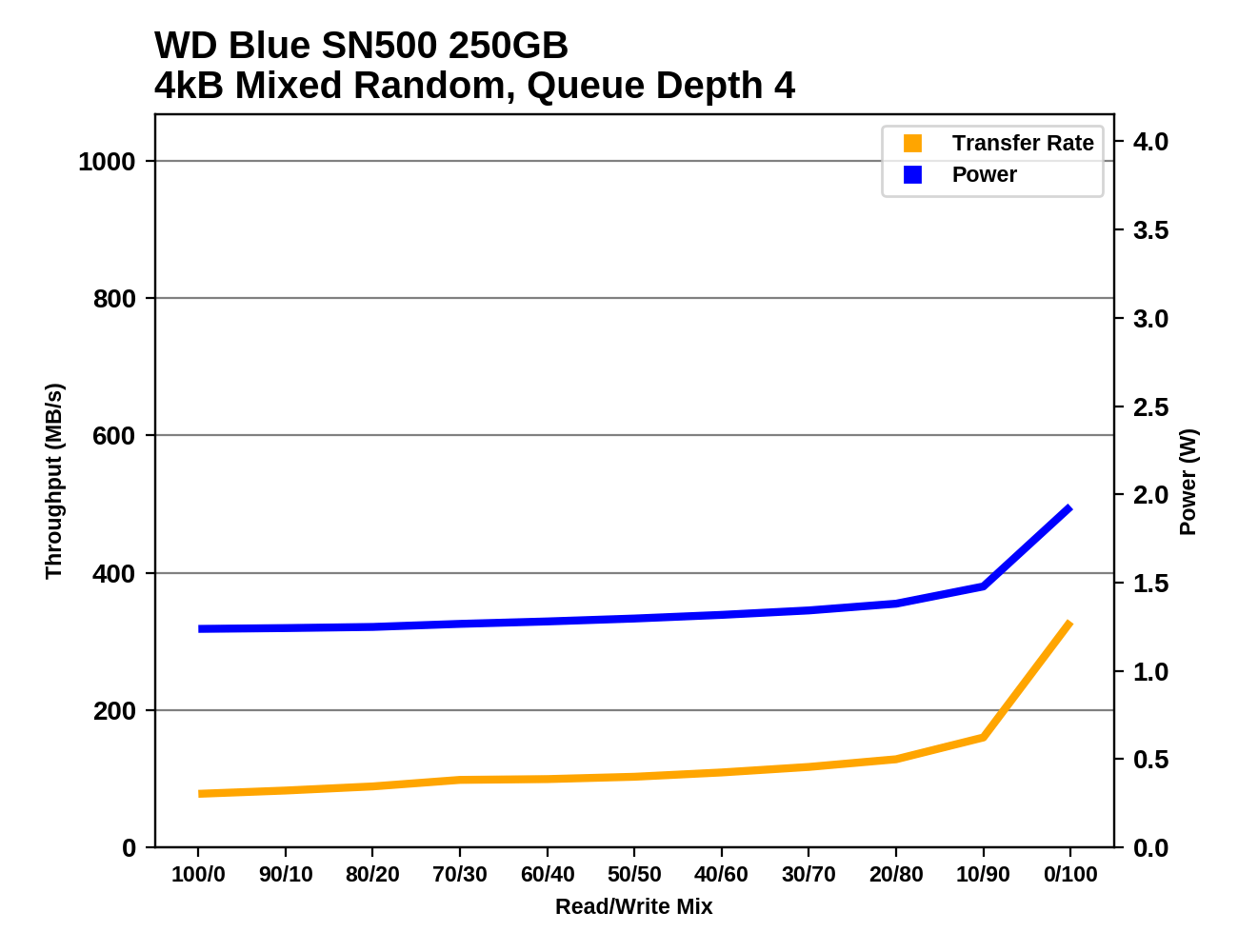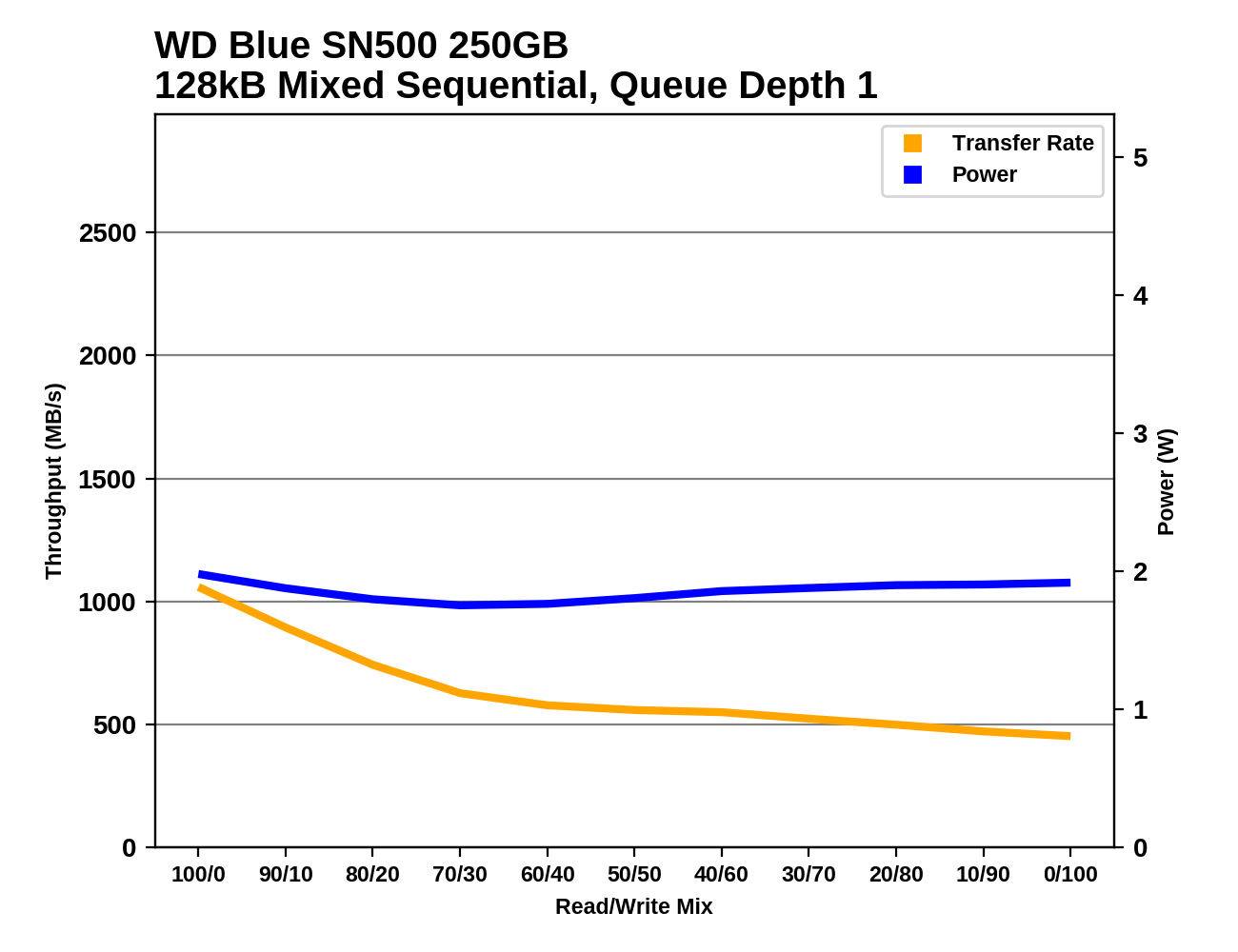The Western Digital WD Blue SN500 SSD Review: Moving The Mainstream To NVMe
by Billy Tallis on April 19, 2019 9:30 AM ESTMixed Random Performance
Our test of mixed random reads and writes covers mixes varying from pure reads to pure writes at 10% increments. Each mix is tested for up to 1 minute or 32GB of data transferred. The test is conducted with a queue depth of 4, and is limited to a 64GB span of the drive. In between each mix, the drive is given idle time of up to one minute so that the overall duty cycle is 50%.

The WD Blue SN500 is very slightly slower on the mixed 4kB random IO test than the larger WD Blue SATA SSD, and is significantly slower than the various high-end NVMe models. The other two entry-level NVMe drives are even slower than the SN500.
 |
|||||||||
| Power Efficiency in MB/s/W | Average Power in W | ||||||||
Despite relatively low performance, the WD Blue SN500's efficiency score on the mixed random IO test is a bit above average due to it drawing far less power than most of the high-end NVMe SSDs or even the SATA drives that outperformed it.
 |
|||||||||
The WD Blue SN500's performance on the mixed random IO test shows a fairly normal slow growth in performance as the workload shifts to be more write-heavy. At the very end, the ability to combine writes without any read operations getting in the way leads to a jump in performance even though the SLC write cache is full during almost all of this test.
Mixed Sequential Performance
Our test of mixed sequential reads and writes differs from the mixed random I/O test by performing 128kB sequential accesses rather than 4kB accesses at random locations, and the sequential test is conducted at queue depth 1. The range of mixes tested is the same, and the timing and limits on data transfers are also the same as above.

The WD Blue SN500 cannot compete with most of the high-end NVMe SSDs on the mixed sequential IO performance test, but it offers decent overall performance that is a bit higher than some of the other low-end NVMe drives and is a clear step up from any of the SATA drives.
 |
|||||||||
| Power Efficiency in MB/s/W | Average Power in W | ||||||||
The power efficiency of the SN500 on this test is quite a bit lower than what the 1TB WD Black SN750 delivered, but among other 256GB-class drives the SN500's efficiency is top-tier.
 |
|||||||||
As writes are added to the workload, the WD Blue SN500's performance drops—quickly at first, but then almost leveling out as the drive approaches SATA speeds. By the end of the test when the workload is pure writes, the SN500 is performing below theoretical SATA limits, but beats any actual 256GB-class SATA drive we have on hand.










50 Comments
View All Comments
Marlin1975 - Friday, April 19, 2019 - link
Actually not bad for one that does not have any large external buffer. That and this is the 250gb model so the 500 should perform a little better as well.Dragonstongue - Friday, April 19, 2019 - link
970 Evo Plus quite stands out for NVME based drives at ~$35 more for same size (just did a price check, amazon, 500gb for this vs 970 evo plus)so while "on paper" this appears great price, is still in very tough ground with ample contendors such as crucial with their p3 ( I believe it was called) countless samsung entries and the like.
for an extra ~$30-$40 seems like "normally" is just not worth it when can do for ones self (such as clock up the slower product, tweaking voltages and the like) when it comes to a "paper" difference and more or less proven real world data this is not all that good a price.
IMO is we take even a high performance HDD as a regular car speed, sata ssd (even highest performance) still is like an expensive supercar speed difference, the next jump would be the nvme based ones which are like top fuel dragsters (at best) but few tracks let them breathe proper and have to deal with engine problems (throttling etc) that normal drive do not have to deal with AND more $$$$$$..
top fuel costs $$$$, do you ALWAYS see this speed, nope, but when you do, is wonderful, when you do not, it becomes a "so why did I pay that much more for little gain and loss in capacity as well as specific motherboards to tap the advantage" etc etc.
kudos to WD, but alas, the margins are so very narrow and expected performance so high is near a non starter for all companies.
I feel the "new standard" for storage should be @500gb for performance and capacity reasons with 1tb prefered (even a 250nvme + whatever size SSD flash in a raid internal no driver required fashion .. I always liked concept of hybrid drives, why not use hybrid memory styles to leverage as well, instead of saddling fast memory with spinning rust, use high speed low endurance flash with lower speed high endurance other flash.
they do pci-e basd, nvme based, sata based etc etc, all have own benefit and detriment. I personally love sata based, leave the motherboard real estate for other things, they should do a further rendition of sata for the hole outs (like me and others whom have a variety of reasons)
if they can patch pci-e to nvme, why not use sta 6 (like current) but tap x2 or x4 pci-e lanes to it as well, let us call it SATA-X, backwarrds compatible with Sta 6g to sata 1 ofc, this would allow some sata or whatever drives up their speed but use a familiar/durable/more widespread form factor.
if all nvme based drives would work in all board or they would not interfere with mobo, not have throttle issues because of dog meta cooling designs (motherboard AND drive maker often enough) it would not be as much an issue, I like sata drive for such reasons, mainly can look "nicer" tend to be much more durable, that much less costly etc etc.
anyways, if WD could do 500 for the price of the 250, that would be most excellent, but as the pricing is, mehhh, overall nice rounded performance with no real shortcomings compared to many others even some of the much more $ drives are not as "rounded" for this they at least did very well at, that much should be said.
like Crucial with MX100, MX500, Samsung with the 800 through 970s (sata and nvme ofc) there are levels that are nice to hit, this SN500 is very much on that edge, up the performance a tough more, reduce price a touch (keep say $40 or better gap between this and the 970 evo plus) then this is that new "leg"
crucial 100/mx500 are more "budget" compared to the "sometimes" faster sammy 8xx/9xx drives, sammy ofc got the speed and endurance markers out there, this "could be" that leg of "rounded performance" just like the mx500 or sammy 8xx/9xx evo ^.^
sonny73n - Saturday, April 20, 2019 - link
Is this a comment or an essay?Hul8 - Saturday, April 20, 2019 - link
"Stream of consciousness" is a style, but usually only applied to fiction.LMonty - Sunday, April 21, 2019 - link
Haha! He just needed to get it out of his system :)Thud2 - Saturday, April 20, 2019 - link
Can you elaborate?Jorgp2 - Sunday, April 21, 2019 - link
Pretty sure this is targeted mostly at OEMsDyneCorp - Wednesday, April 24, 2019 - link
The MX500 is on par with the 860 EVO. SSDs with Micron 64-layer 3D TLC NAND and the SM2262 controller (HP EX920 and ADATA SX8200) absolutely destroy Samsung 9 series NVMe SSDs in certain metrics.The initial price of any product is always high. The SN500 will drop in price. In fact, its not even selling at its suggested retail price from most retailers.
And by the way, comparing SSDs to motor vehicles is ridiculous. Please stop.
jabber - Friday, April 19, 2019 - link
It will do fine for a Steam drive.fazalmajid - Friday, April 19, 2019 - link
I don’t see how such puny capacities can be mainstream, specially when most motherboards or laptops have a limited number of M.2 slots. My minimum would be a 1TB or 2TB Intel 660P.